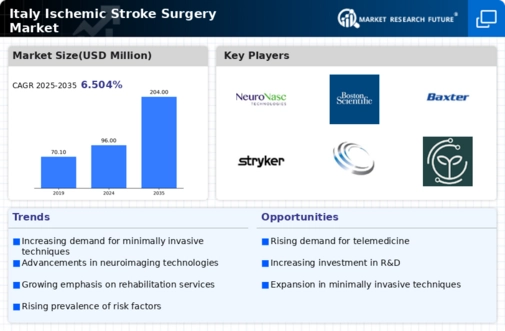Growing Aging Population
The aging population in Italy is a crucial driver for the ischemic stroke-surgery market. As individuals age, the risk of ischemic strokes increases significantly, leading to a higher demand for surgical interventions. According to recent demographic data, approximately 23% of the Italian population is over 65 years old, a figure that is projected to rise. This demographic shift necessitates enhanced healthcare services, particularly in neurology and surgical care. Hospitals and healthcare providers are likely to expand their capabilities to address the increasing incidence of strokes among older adults. Consequently, this trend is expected to stimulate growth in the ischemic stroke-surgery market, as more patients seek timely and effective surgical solutions to manage their conditions.
Increased Healthcare Expenditure
Rising healthcare expenditure in Italy is a pivotal factor influencing the ischemic stroke-surgery market. The Italian government has been increasing its healthcare budget, with a focus on improving surgical services and stroke care. In 2025, healthcare spending is projected to reach approximately €200 billion, reflecting a commitment to enhancing medical infrastructure. This financial support enables hospitals to invest in advanced surgical equipment and training, thereby improving the quality of care for stroke patients. As a result, the ischemic stroke-surgery market is likely to benefit from this increased funding, facilitating better access to surgical interventions and ultimately improving patient outcomes.
Growing Public Health Initiatives
Public health initiatives aimed at reducing stroke incidence are becoming increasingly prevalent in Italy. Campaigns focused on educating the population about stroke risk factors, such as hypertension and diabetes, are likely to lead to earlier detection and treatment. The Italian Ministry of Health has launched several programs to promote awareness and prevention strategies, which may contribute to a decline in stroke-related morbidity. As more individuals become informed about the importance of timely medical intervention, the demand for surgical procedures in the ischemic stroke-surgery market is expected to rise. This proactive approach to health management could significantly impact the market dynamics in the coming years.
Advancements in Surgical Techniques
Innovations in surgical techniques are transforming the landscape of the ischemic stroke-surgery market. Minimally invasive procedures, such as endovascular thrombectomy, have gained traction in Italy, offering patients reduced recovery times and lower complication rates. Recent studies indicate that these advanced techniques can improve patient outcomes significantly, with success rates exceeding 80% in certain cases. As hospitals adopt these cutting-edge methods, the demand for skilled surgeons and specialized training programs is likely to increase. This evolution in surgical practice not only enhances patient care but also drives market growth, as healthcare facilities invest in the latest technologies and training to remain competitive in the ischemic stroke-surgery market.
Collaboration Between Healthcare Providers
Collaboration among healthcare providers is emerging as a vital driver for the ischemic stroke-surgery market. Integrated care models that involve neurologists, surgeons, and rehabilitation specialists are being developed to ensure comprehensive patient management. This multidisciplinary approach is likely to enhance the quality of care and streamline the surgical process for stroke patients. In Italy, hospitals are increasingly forming partnerships to share resources and expertise, which may lead to improved surgical outcomes. Such collaborations not only foster innovation in treatment protocols but also contribute to the overall growth of the ischemic stroke-surgery market, as they facilitate better patient access to necessary surgical interventions.




















Leave a Comment